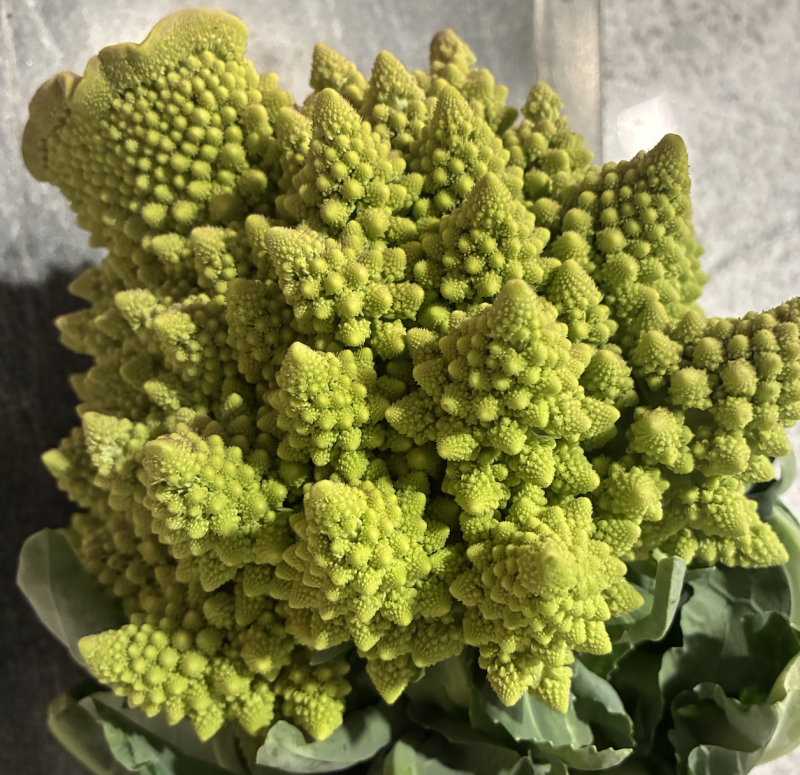Romanesco brings visual interest, nutty flavor to fall menus
The sign at Rays Produce and Flowers said “Romanesco ~ love child of broccoli and cauliflower.” The odd-shaped, chartreuse head of tiny buds did have some resemblance to a head of cauliflower, but the bright-green color didn’t belong to any type of broccoli. Botanically, romanesco is a brassica, the result of selective breeding of cauliflower varieties during the 1500s in the Lazio region of Italy. You may also see it called romanesco broccoli or Roman cauliflower.
Its unique appearance features small buds in a spiral pattern that form into peaks. Romanesco is considered a fractal because of the overall repeated pattern, in which each part of the vegetable resembles the whole. Looking further, you will discover that romanesco is also a math wizard.
It is a perfect example of the Fibonacci sequence, also known as the golden ratio, a logarithmic spiral in a perfect geometric progression where the next number is always the sum of the previous two numbers. In romanesco, you will see increasingly larger clusters of buds made from smaller, identical peaks of buds. Genetically, these plants have been bred to never flower, but to continue forming buds.
In the garden, romanesco is considered a cool-weather crop, and this is the time of year when it will be available at specialty markets. It is possible to eat the leaves around the base of the head, especially if they are young and tender. Older, tougher leaves can be used in soups and stews, or simmered like collard greens. The leaves are faintly bitter with a nutty flavor.
To prepare romanesco, you can break it into florets and serve it as part of a crudités arrangement alongside spicy dips. You can also cut the florets into bite-sized pieces to add crunch to a salad. The best way to enjoy the taste of romanesco is to roast the florets with a bit of olive oil and lemon zest, as in the recipe below. The slightly sweet, mild flavor is enhanced by the gentle roasting.
Another way to enjoy this vegetable is to create a sauce for pasta. In the recipe below, the same pot of water is first used to tenderize the romanesco and then to boil the pasta. Select a small-sized pasta, as the sauce is somewhat delicate and the romanesco cooks down into small pieces. You can modify the sauce with more ingredients, such as anchovy filets, but this simple version is nice for a quick dinner; just add a salad.
Keep in mind that its flavor is closer to broccoli when served raw and becomes more like cauliflower once cooked. And, when cooking romanesco, make sure not to overcook the florets, or they will become mushy and tasteless. Not many cookbooks feature recipes for romanesco, as it wasn’t introduced to this country until the 20th century. But, you’ll find any number of recipes in online sources.
One last comment about romanesco, the vegetable — it is not the same as the Romanesco dialect or style of poetry. However, the poet Giuseppe Belli penned verse in this dialect and style about a farmer known for growing and selling romanesco.
Lemon Roasted Romanesco
1 head romanesco
2 T olive oil
2 t lemon zest
salt & pepper, to taste
Preheat oven to 425 F. Line a baking sheet with parchment paper; set aside. Cut the romanesco into florets. Place them on the baking sheet in a single layer. Drizzle with olive oil, then stir with a spatula to coat completely. Grate lemon zest over the florets. Season to taste with salt and pepper. Bake until browned and tender, about 20 minutes. Yield: 6 servings.
Romanesco & Pasta*
1 head romanesco
1/4 C olive oil
5 thinly sliced garlic cloves
1 pinch red pepper flakes
2 T tomato paste
pepper, to taste
8 oz small dried pasta (mezzi rigatoni or ditalini)
salt, to taste
Grated Parmigiano-Reggiano, for serving
Remove the stem end and trim leaves from the romanesco head. Cut florets into 1/2-inch pieces. Bring a large pot of salted water to boil. Add romanesco florets and cook until tender, about 6 minutes. In a large skillet, heat olive oil with garlic and red pepper flakes over medium until garlic just starts to turn golden, about 2 minutes. Stir in tomato paste and reduce heat; cook about 2 minutes longer. Season with black pepper. Using a slotted spoon, transfer romanesco to skillet. Immediately add dried pasta to same pot of water and cook until al dente according to package instructions. While the pasta boils, cook romanesco over low heat until very tender and starting to break down, about 5 minutes. Remove 1 C of pasta water, then strain pasta and add to skillet along with 1/2 C of the pasta water. Cook until pasta water has reduced and sauce coats the pasta, about 3 minutes. Season with salt to taste. Serve garnished with grated cheese. *Adapted from Serious Eats.

























































